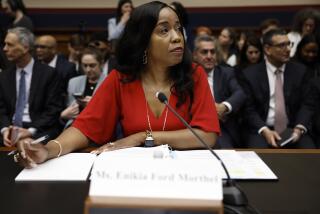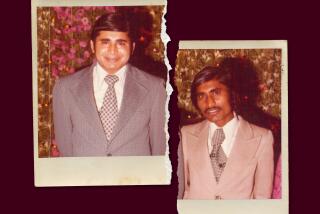The Ranks of Shakers Have Dwindled but Their Spirit Still Survives
The white clapboard buildings of Shaker Village, sitting atop a hill surrounded by fields, seem as forlorn as beach houses boarded up for the winter.
Three women in their 90s are all that are left of a community of about 400 men, women and children, whose simple and reverent lives reflected the religion that brought them there.
As prophesied by the woman who brought Shakerism to America, there are only a handful of Shakers alive today anywhere, including the three elderly women who live here, five who live in Sabbathday Lake, Me., the only other active Shaker community, and three people whose membership status is in dispute.
But Shaker Village is not always so quiet as it is in the dead of winter. Last summer, more than 38,000 people visited the village, which has 22 buildings scattered over 200 acres.
“Some of them come in tears, and they want to take our hands and they just love it,” says Eldress Gertrude Soule, 93.
“They feel the love,” says Eldress Bertha Lindsay, 90, who is blind.
Last Official Members
The two eldresses, along with Sister Ethel Hudson, 91, and five other sisters in Sabbathday Lake are the last official members, those whose names are entered in a registry book called the Covenant.
Originating in England in the 1770s as the Shaking Quakers, the religion grew strong under the leadership of “Mother” Ann Lee, who moved to New York in 1774 with eight followers. The Shakers, formally the United Society of Believers in Christ’s Second Appearing, gained their nickname from their trembling produced by religious emotions. They once numbered about 6,000 members in 24 communities.
Their communal, self-sufficient life style reflected the basic tenets of their religion.
Men and women, who remained celibate, sat at separate tables and entered most buildings through separate doors. But because Shakers believe all are equal, two eldresses and two elders formed the ministry that made decisions for the society, an equality unheard of for most women in the 19th and early 20th centuries.
Since property was shared, converts turned over everything from farms to tools upon entering the society. Each new convert confessed his sins to an elder or eldress.
Refused to Fight
Shakers were conscientious objectors, refusing to send their men into the Civil War and the two World Wars.
Like many Shakers, Eldress Bertha came to Canterbury in 1905 as an orphan. Eldress Gertrude and her sister went to Sabbathday Lake in 1906 after their father married an unkind stepmother.
“The sisters were so kind and gentle,” said Eldress Gertrude, a small woman with sharp blue eyes who came to Canterbury in 1971. “I was so happy to get where I could be a real child again.”
In her musical voice, Eldress Bertha described life at Shaker Village.
Up for breakfast at 6 a.m., the Shakers had Bible reading, then went to work planting gardens, sewing clothing and making the simple, efficient tools and furniture for which they are famous, including the flat broom, clothespin and ladderback chairs.
After stopping at noon for dinner, they resumed working until about 4:30 p.m., when they were free to do as they pleased.
“I liked the variety of work,” she said. “I didn’t have to stay at one job all the time. We rotated our work so we could learn every trade. I love cooking, and I did take part in canning of the fruits and vegetables in the summer. . . . It was not monotonous in any way.”
Like everyone who came to the Shakers, the eldresses were not required to stay.
“I did think of leaving at one time when I was young, before I had become a sister,” Eldress Bertha said. “It was around the age of 17 or 18. But I soon decided against it because I felt I should return to this family what had been given to me.”
The vow of celibacy also was a challenge at times.
“Of course, when you’re young you have high thoughts,” said Eldress Gertrude. “But you’re living in a community where a lot of sisters and brothers are living a celibate life and you don’t think anything about it.”
Shakers believe God gave everyone a mission, she said.
“Whoever’s mission it is to marry and bring new life into the world, that’s their mission,” she said. “Our mission is to live as near as we can to Christ’s teachings.”
The Shakers’ numbers began to dwindle as times changed. Society began creating homes for orphans and others left alone in the world, so the Shakers’ open doors were less in demand.
By the late 1950s, just two dozen Shakers remained. After setting up a trust to protect their remaining villages, the Shakers’ lead ministry, made up of three eldresses, decided in 1965 to close the Covenant and admit no new members.
Open to New Members
The Sabbathday Lake village refused to heed the decision and continues to be open to new members.
The 1965 decision and ensuing rift between the villages remains a sensitive subject, which the surviving eldresses are reluctant to discuss.
Scott DeWolfe, research assistant at the Sabbathday Lake community, said three new people have been taken in since then. He calls them brothers and sisters and does not distinguish them from the five covenanted sisters.
“The community here has never closed their Covenant as far as they’re concerned,” DeWolfe said. “Being a Shaker is just living the principles of the Shaker faith.”
Richard Morse, the Shakers’ lawyer, said the rift has long since been mended and members of the two communities serve on one another’s boards and have other mutual business.
The eldresses believe the decline in membership fulfills Mother Ann’s prophecy that Shakers “would diminish to as many as a child could count on one hand, and then there would be a revival of the spirit,” Eldress Bertha said.
“It wouldn’t be called Shakers. They wouldn’t live in communities. But it would be worldwide felt and known. And we think that is coming to pass.”
More to Read
Start your day right
Sign up for Essential California for news, features and recommendations from the L.A. Times and beyond in your inbox six days a week.
You may occasionally receive promotional content from the Los Angeles Times.






